Abstract
In this article, a collective database from validated numerical simulation has been established to study the suppression effects of water-based suppression systems under a single-compartment fire scenario at various suppression configurations and fire locations. Five fuel locations along the axis between the centre and corner of the room were configurated to dynamically analyse how the horizontal distance between the nozzle and fuel pan affects the heat release rate (HRR), temperature cooling phenomena at different heights and also the velocity profile. Throughout the fuel pan relocations, the water-mist system has achieved an average suppression time of 25 s for all the locations, it was found that the water mist system can effectively control the fire under 200 °C that is distanced over 2 m spanwise displacement from the nozzle against the fire, while the sprinkler has exhibited an excellent fuel surface cooling effect due to large momentum and heat capacity within the coverage area with an average suppression time of 50 s. The results of this study have further explored the spray coverage and droplet penetrability of different suppression systems at different locations corresponding to the fire source, and the quantitative assessment of fuel locations could also contribute to the future development of performance-based fire safety designs.
1. Introduction
In Australia, tragedies such as the Bankstown and Quakers Hill Nursing Home fire incidents [1,2] have resulted in fatalities and miserable losses. They have highlighted the consequences of the absence of fire suppression systems in confined premises. These devastating fire events were challenging to fight against once flashover had occurred, which makes it exceptionally difficult to carry out effective fire rescuing operations and hinders occupants from seeking a safe escape route [3,4]. The past fire incidents and the statistic matrix have highlighted the importance of automated suppression systems in various infrastructures [5]. Hence, water-based suppression systems have been developed over the past two centuries and are utilised worldwide in commercial and residential buildings [6]. Besides conventional fire sprinklers, water mist systems have become a popular suppression solution in recent decades, as it requires less water consumption to achieve rapid suppression in confined spaces [7,8]. Water mist systems are preferable for libraries, aircraft and local stores, where the water damage can be minimised since the nozzle flow rate is nearly an order of magnitude less than fire sprinklers [9,10]. The water mist system is defined as 99% of the droplets being regulated under 1000 µm, while the droplet size of fire sprinklers lies between 1000 µm–4000 µm [11]. The suppression mechanisms for conventional fire sprinklers and water mist systems are distinct from each other as a result of their difference in size of water droplets. Vast numbers of large-scale fire experiments have been carried out to study the interaction between fire plumes and water-based suppression systems [12,13,14], where fire sprinklers utilise large diameter water droplets in order to cool down the flame and combustible materials’ surface [15,16], while water mist applies water droplets with sizes smaller in few orders of magnitudes. With smaller droplets, water mist systems suppress fire by cooling flame surface and volumetric displacement of combustive gas [17]. Micro-droplets evaporate rapidly when in contact or descending towards the flame, forming a steam enclosure to insulate oxygen from the combustion [18].
Although immense experiments have been carried out to provide insights into the effectiveness of different water-based suppression systems, a quantitative assessment of spray configurations (i.e., droplet sizes, flow rate, nozzle type, fuel locations etc.) is required to deliver an optimal design of water spray system [19]. Therefore, computational fluid dynamics (CFD) has become a cost-effective approach to study the complex interactive fire behaviours associated with suppression effects, considering large-scale fire experiments are often costly and destructive. Pioneer fire suppression modelling studies established by Alpert [20], Nam [21], Chow et al. [22] and Hua et al. [19] numerically described the interaction between water sprays and fire plume (i.e., mass, momentum and energy), created solid foundations for future Eulerian-Lagrangian based fire suppression modelling. To date, extensive numerical studies have been performed to study the suppression behaviour of water-mist systems under different configurations and fire scenarios. Wang et al. [23], Liu et al. [24] and Mahmud et al. [25] have studied the effects of different droplet sizes offered on droplets’ penetrability and the evaporating rate at the flame region. Other spray characteristics such as spray angle [26], nozzle type [27], flow rate and operating pressure [28] have also been investigated through numerical studies. Moreover, a wide range of simulation studies suggested that fire compartment characteristics, including the physical configuration of the fire compartment [29], ventilation conditions [30], the distance between the water nozzle and ignition source [31] and fire sizes [32] could also heavily affect the suppression efficiency of the systems. Among the numerical studies, Lee et al. [31] have firstly explored the effect of the distance between a water spray nozzle and a fire on heat release rate (HRR). However, the investigation ceased at correlating the relationship between suppression time and nozzle distance. The actual physical phenomena of the suppression effect at different fuel locations have yet to be studied, including the impact of different nozzle configuration and droplet sizes on surface cooling and gas displacement effect. It is essential to further investigate the suppression behaviour of water-based suppression systems under different fuel location displacement, a quantitative assessment of fuel locations could contribute to the development of performance-based fire safety designs [33].
In light of the aforementioned knowledge gap, this study aims to numerically investigate the droplet behavior of water-based suppression systems in terms of droplet impact and the relationship with the fuel source location in different benchmarking room fire scenarios. The following are the objectives for this study:
- (i)
- Establish a predictive fire model to simulate sprinkler and water mist fire suppression system in a room fire scenario, and validate the model via comparison against referenced experimental data;
- (ii)
- Perform a series of numerical case studies by adjusting the fire location with different nozzle configurations;
- (iii)
- Compare the spray mechanisms and coverage area of water-mist against convention fire sprinkler systems;
- (iv)
- In-depth analysis of the fire suppression efficiency in terms of penetration capacity between the buoyant flaming fluid mixture and water droplets;
2. Computational Methods
Under the Eulerian-Lagrangian framework, computational fluid dynamics coupled with discrete phase model (CFD-DPM) is a viable approach to predict the complex interactive fire behaviours associated with suppression effects. This approach has been widely employed for numerical fire suppression studies [34,35,36,37,38]. In this study, Fire Dynamic Simulator (FDS) version 6.7.4 has been employed to simulate a compartment fire with droplet suppression effects. FDS, developed by the National Institute of Standards and Technology (NIST), is one of the most recognisable simulation codes in the fire safety community. It utilised the Large Eddy Simulation (LES) approach incorporating sub-grid scale (SGS) turbulence models coupled with combustion, radiation and droplet models to account for the essential fire phenomena interacting with water droplets. The LES approach is appropriate for fire modelling since the temporary fluctuation behaviour of the flame can be coupled to the other sub-modelling components [39,40,41].
2.1. Governing Equations, Turbulence Model
In the FDS framework, the transport equation of fluid flow in LES approach is described by the fundamental conservation equations for Newtonian fluid [42]. While the low Mach number assumption is made [43], the pressure of low-speed applications such as fire will be resolved into the background pressure , internal energy and enthalpy is integrated in terms of sensible enthalpy . Eventually, the transport equation for mass, momentum and energy is derived to perform the reaction between water droplets and fire, accounting for the heat release rate per unit volume from the combustion , the heat transmitted to the water droplets and , which represents the heat flux transmitted through conduction , diffusion and radiation .
where is density, is the flow velocity, is the thermal conductivity and is the diffusivity of species “i”.
The composition of turbulent flow possesses large eddies that involve a wide range of length and time scales, and a filter implementation is required in order to distinguish eddies by various sizes. The cut-off size of the filter is established by the grid size of the simulation. Eddies that are larger than the filter scale will be directly resolved, while the Subgrid-Scale turbulence model approach will predict the remaining eddies. In this study, the Wall-Adapting Local Eddy-viscosity (WALE) model developed by Nicoud and Ducros [44] was employed. The WALE model has been extensively utilised in various fire formation studies and fire case investigations [45,46,47,48], which approaches the eddy viscosity as:
where is the size of the filter, and the modelling constant is suggested for decaying isotropic turbulence.
2.2. Combustion Model
Combustion in the FDS is constructed based on the mixture ratio of the species in the fuel, while assuming the oxidant and fuel are burnt instantly once mixed. The default chemical kinetics is simplified as a one-step reaction where fuel reacts with ambient air (i.e., oxygen, nitrogen, water vapour and carbon monoxide) directly to form the final products (i.e., nitrogen, carbon monoxide, carbon dioxide, water vapour and soot). The heat released from combustion has always been an essential parameter that defines the scale and the magnitude of a combustion model. As combustion in the FDS model is depended on the fuel’s lumped species fraction, the heat released per unit volume of the combustion is defined by multiplying the heat of formation and the mass production rate of each lumped species .
2.3. Extinguishment and Evaporation
2.3.1. Extinction Model
The reaction between the fire and water droplets is critical in a suppression efficiency study. In order to replicate the phenomena of fire extinction, an extinct model (EXTINCTION 1) in FDS has been implemented. In the extinction model, diffusion flame extinguishment is indicated by the critical flame temperature , limiting oxygen index and the “free-burn” temperature . While the cell bulk temperature is suppressed below , the limiting oxygen volume fraction , which is calculated by and , will be considered into the extinction model. The local cell mass production rate and heat release rate will be zero once the bulk oxygen concentration is lower than .
2.3.2. Droplet Evaporation Models
The major differences between fire sprinklers and water mist systems were due to the varieties in droplet diameters. Especially, the water mist system achieves combustible gas displacement via rapid droplet evaporation. It is essential to consider the evaporation effect in terms of latent cooling in the current model. The mass and energy conservation in the process of evaporation is revealed as [49]:
Equations (9) and (10) revealed the mass transfer in the process of evaporation; the and represent the vapour mass fraction in the liquid and local gas-phase, while the energy transfer is revealed by and , which represents the temperature of the droplet and local gas. In these equations illustrated above, and are the mass of the droplet and local gas, is the surface area of the droplet, stands for mass transfer coefficient, is the heat transfer coefficient between the droplet and local gas, is the latent heat of evaporation and is the specific enthalpy of the droplet, and are the specific heat capacity for liquid and gas-phase, is the rate of radiative heating of the droplet and represents the density of the local gas phase.
During the interaction between water droplets and fire, except for simple heat transfer correlations, the pyrolysis rate of the fuel and droplet transport on the fuel surface are also considered. The reduction of the fuel ejection rate due to water suppression was characterised by Yu et al. and Hamins et al. [50,51]:
where is the total heat release rate at the time of application and k is the fuel-dependent constant. To further investigate the local fire, the burning rate of the fuel was observed to be an exponential nature with the water suppression both locally and globally, where is the local water mass per unit area. is suggested to be 16.4 through the calibration of extinguishing coefficient against liquid fuel fire conducted by Lee [52].
3. Experiment and Numerical Configurations
3.1. Compartment Geometry
This numerical model was constructed according to the water mist enclosure fire suppression experiment conducted by Kim et al. [14]. The experiment compartment consists of a 4 m × 4 m × 2.3 m room with an elevated fume hood on the ceiling, and with methanol fuel pan at the centre of the room. The compartment geometry was first created in AutoCAD according to the dimensions provided by the original experiment before being imported into FDS, as illustrated in Figure 1. The mesh boundary is precisely constructed by the same dimension of the compartment in x and y-direction (, an open boundary was configured for both the door and the fume hood and the z-direction domain is limited at 2.8 m from the ground in order to enhance the smoke ventilation of the model and decrease model instability due to great interior pressure of the compartment. As a result, the total size of the computational domain is 4 m × 4 m × 2.8 m.
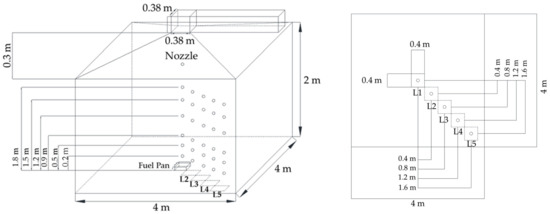
Figure 1.
Schematic of the testing compartment.
3.2. Fuel Pan/Combustion Configuration and Measurement
A methanol (CH3OH) fuel pan with dimensions of 0.4 m × 0.4 m × 0.05 m is located at the centre of the compartment with a mass loss rate of 0.0155 kg/m2s, corresponding to a heat release rate (HRR) of 310 kW/m2. The heat of combustion, radiative fraction, soot yield, oxygen index and critical flame temperature for methanol fuel were input according to the SFPE Handbook [53]. In this study, the fuel pan will be located five locations away from the nozzle to examine the suppression effectiveness. Each location is relocated 0.4 m away from both X and Y axis. Six thermocouples and six gas probes are also configurated at each fuel location from 0.2 m–1.8 m above the ground, as depicted in Figure 1 and Figure 2.
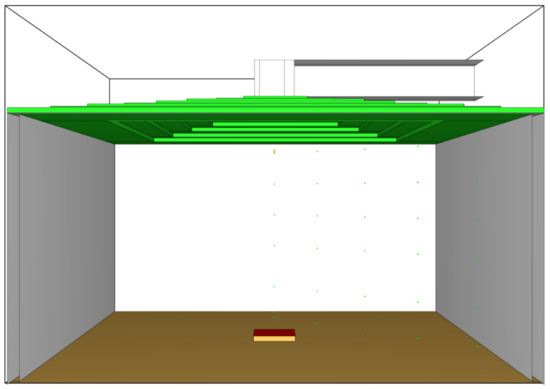
Figure 2.
Snapshot of the compartment geometry in FDS.
3.3. Suppression Systems
The sprinkler/mist nozzle is located at the centre of the room at a height of 2 m. The suppression systems were configurated according to numerical fire suppression studies on both fire sprinklers and water mist systems established by Liu et al. [24,54,55], where the sprinkler configuration was verified by Bourque et al. conducting bucket tests [56,57]. The detailed setup for the numerical model, including nozzle configuration, is summarised in Table 1. Despite the difference in activation mechanism between fire sprinklers and water mist systems (i.e., temperature glass-bulb, heat detection etc.), both of the systems were activated when the thermocouple 1.8 m above the fire reached 85 °C to compare the after-activation suppression effect systematically.

Table 1.
Simulation setup.
3.4. Mesh Independence and Validation
A grid sensitivity study based on DiNenno et al.’s approach [58] was conducted by simulating one of the cases with three scales of mesh sizes, namely coarse (352,000 cells), moderate (1,645,077 cells) and fine (2,841,600 cells). The grid sizes were determined considering characteristic diameter (D*):
where the heat release rate Q, density , specific heat and the ambient temperature of the air are considered.
The grid sensitivity tests are illustrated in Figure 3, where temperature profiles obtained during suppression events at the height of 0.5 m were used as the monitoring point. The trend of the temperature growth was reflected for all three sets of meshes. After the temperature becomes stabilised during combustion, it can be seen that the variation between moderate and fine mesh is less than 10%. To minimise computational cost with satisfying accuracy, the moderate meshing (1,645,077 cells) with a uniform grid size of 0.03 m is applied for further analysis. The numerical model was validated against the experimental data from Kim et al. [14]. Figure 4 shows the temperature comparison between the numerical predictions and experiments at (a) ceiling location 0.5 m away from the centre without suppression and (b) at 1.8 m above the ground during suppression. The fire field model has exhibited acceptable accuracy in predicting field temperature without or during suppression events.
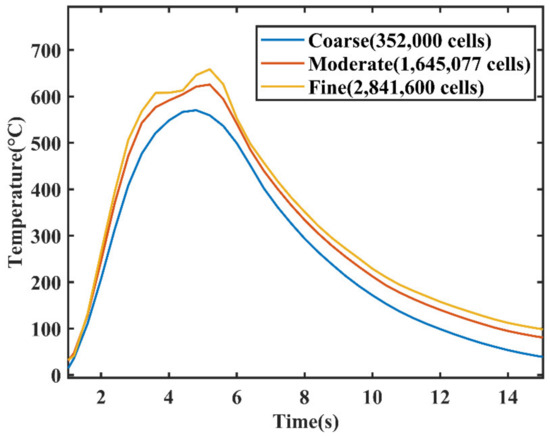
Figure 3.
Comparisons of the temperature profile in location 1 fire for coarse, moderate and fine meshes.
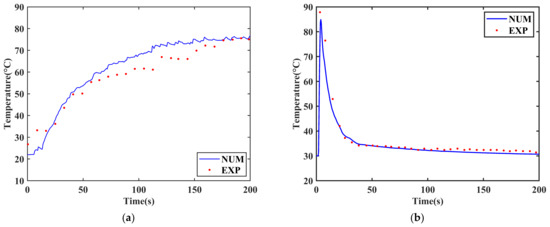
Figure 4.
Validation of the numerical model against experimental results (a) ceiling location 0.5 m away from the centre without suppression and (b) at 1.8 m above the ground during suppression.
4. Results and Discussion
The current study investigates the suppression effects of fire sprinkler and water mist systems under a single-compartment fire scenario. Five fuel locations along the axis between the centre and corner of the room were configurated, and a collective database was established to dynamically analyse how the horizontal distance between nozzle and fuel pan affects the heat release rate (HRR), temperature cooling phenomena at different heights and also the velocity profile. The results of this study can further explore the spray coverage and droplet penetrability of the suppression systems at different locations.
4.1. Fire Suppression Process Reflected by Heat Release Rate (HRR)
Figure 5 compared the fire development and suppression process with both water mist and conventional fire sprinkler systems in 400 s via HRR profiles. In all cases, a peak HRR of approximately 50 kW was achieved before the fire suppression systems were activated. As depicted in Figure 5a, it can be observed that the fire sprinkles achieved a significant HRR deduction in 4 out of 5 locations within 200 s, while for water mist systems (Figure 5b), full deductions of HRR were only achieved in 2 out of 5 locations (locations 1 & 2). A detailed HRR deduction time for all cases has been summarised in Table 2. Firstly, location 1 is the most common fuel location employed in fire suppression studies, which is vertically aligned with the nozzle. In this case, the fire sprinkler took a much longer duration than the water mist to deduct the HRR profile fully and suppress the fire, while water mist has fully extinguished the fire within 10 s. When the fuel location is being relocated away from the nozzle horizontally, the water mist begins to lose its capability in HRR reduction. In location 3, although the water mist successfully suppressed the fire and reduced the HRR by 68.2%, the suppression procedure took more than 280 s to obtain a stable HRR profile, which is much longer than the sprinkler in this location. The water mist system is even unable to deduce HRR profile and suppress the fire at location 4. For location 5, both systems failed to perform fire suppression in terms of HRR reduction, which indicates that location 5 is out of the spray range of both systems. In this simulation study, the HRR reduction relies on the droplet transport on the fuel surface, hence the performance difference between sprinkler and water mist on various fire locations can be attributed to their difference in terms of the effective coverage area and surface cooling effect induced by the droplet. However, solely HRR profiles could not fully exhibit the suppression behaviour of the suppression systems, other phenomena such as the compartment cooling effect and droplet impact have yet to be investigated, especially when the fire is out of the spray coverage; these will be further discussed in the following sections.
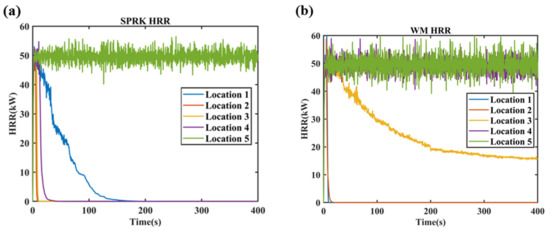
Figure 5.
Comparison of HRR Profiles; (a) Fire Sprinkler (b) Water mist.

Table 2.
Fire suppression reflected by HRR reduction for both systems.
4.2. Cooling Effect Reflected by Local Temperature
Temperature readings can serve as a good indication of the effectiveness of fire suppression systems in controlling fire since the ability to rapidly reduce and stabilise the local temperature field is also essential for an effective suppression system. Figure 6 compares the temperature reading at of 0.2 m, 0.5 m and 1.2 m separately for all the cases; it can be observed that most of the temperature profiles share similar trending behavior with the HRR behavior (i.e., reduction time). However, regardless of the fire suppression outcome (i.e., either fire has been fully suppressed or not), it can be seen that the water mist systems are able to rapidly cool down temperature near fuel source to a low value in all scenarios. Except in location 5, all the temperatures over 0.2 m above the fire have been suppressed below 100 °C within 20 s. This has further exhibited the advantages of water mist. Even though the mist droplets did not effectively reduce the HRR from locations 3–5 due to insufficient droplet transportation on the fuel surface, which can be attributed to small spray coverage or early droplet evaporation, the water mist system can still effectively stabilise the local temperature field at the fuel locations. For location 5, which is considered out of the spray coverage of both systems, the water mist was also able to reduce the temperature relatively lower than the fire sprinkler.
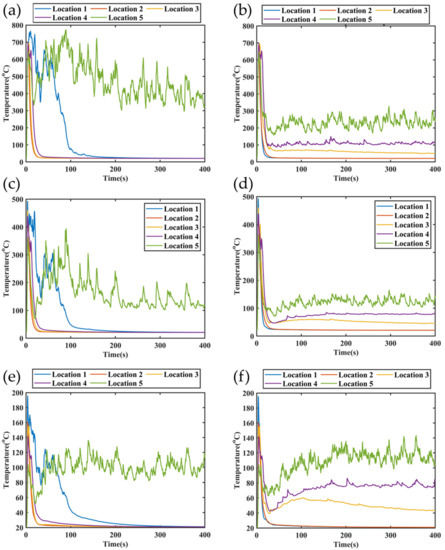
Figure 6.
Temperature profile of each fire location at height of 0.2 m (a) fire sprinkler; (b) water mist.; 0.5 m (c) fire sprinkler; (d) water mist and 1.2 m (e) fire sprinkler; (f) water mist.
To analyse the suppression events systematically, the temperature profiles can be classified into three suppression stages, namely ‘Growth’, ’Reduction’ and ’Stabilisation’. The stage before the nozzle was activated is referred to as ‘Growth’ stage, which is the time windows (tp) that allow the fire develops to reach its peak temperature (Tp). While after the sprinkler/water mist system is activated, the heat reduction rate of the suppression system surpasses the heat release rate of the fire until the temperature is decreased to a level where both heat reduction and release rate become balanced. The stablised temperature at this point can be defined as Ts; thus, fire suppression is achieved. This period is referred to as ‘Reduction’ stage and can be denoted as ts. The ‘Stabilisation’ phase comes after the reduction phase, where the temperature become stable.
Table 3 summarises the key information obtained such as temperature, growth time and reduction time for all cases. Δt is defined as the actual suppression time, which is the time differences between the end of ‘Growth’ and ‘Reduction’ stage (Δt = ts − tp). Similarly, despite the water mist system resulting in a higher stabilised temperature in locations 3 and 4, it managed to maintain a low range of temperature and similar suppression time compared to the fire sprinkler. In this study, the suppression times for the water mist system were approximately 25 s for all locations, while the fire sprinkler was 50 s, excluding location 5.

Table 3.
Summary of key temperature and time for both systems.
Figure 7 compares the temperature reading along the height above fuel locations at different time instances and stages during the fire suppression for all cases. The temperature profile along the height of the room is revealed. In the fire growth stage, most of the temperature profiles for water mist and sprinklers are superimposed before the nozzle is activated. It is observed that when the fire source is located further from the water nozzle (i.e., locations 4 & 5), water mist systems have better control compared to sprinklers at lower heights near the fire source. It is also interesting to note that starting from location 3, the temperature near the ceiling increased during water mist operation, and the phenomenon is more pronounced in locations 4 & 5. In location 5, this phenomenon was witnessed in both sprinkler and water mist systems during operation.
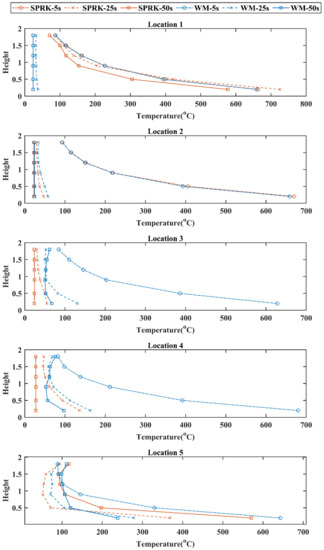
Figure 7.
Temperature distribution along the height of the room for different fire suppression cases.
4.3. Fire Suppression Performance with Spray Coverage
As mentioned in previous sections, a vital difference observed between sprinklers and water mist systems that affected the fire suppression performance for fire at different locations is the spray coverage. Figure 8 illustrates the contours of the mass of water droplets per unit volume at different time instances on virtual sampling planes at 0.1 m above the fire for all cases at different fire suppression stages, this provided a good reflection on the two systems’ spray patterns. With the same spray angle configuration, as droplets emitted from sprinklers process larger momentum, the droplets are able to maintain the original trajectory and thus keep a larger coverage area as set by the spray angle from 10° to 70°. However, for water mist systems, the droplets are concentrated at the center, resulting in a smaller coverage area, albeit they have the same large set spray angle as a sprinkler system. This can be attributed to the fact that droplets from water mist systems carry much less momentum with smaller mass, and the droplets lose momentum quickly due to drag from air and buoyancy induced by fire; thus, they cannot follow the intended trajectory and travel along horizontal distances.
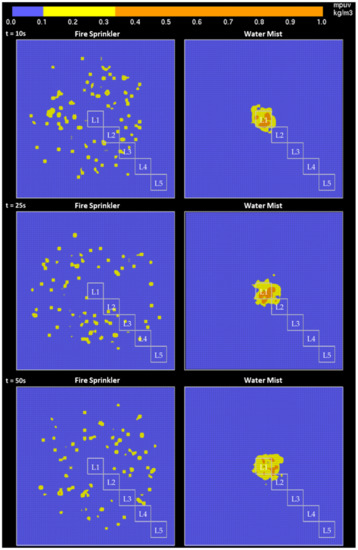
Figure 8.
Density of water droplets sprinkled from sprinkler system and water mist system during the absent of fire.
4.4. Velocity
Besides temperature, velocity vectors before and during fire suppression at locations 1, 3 and 5 are also plotted at the plane crossing the fuel pan in Figure 9, Figure 10 and Figure 11, revealing the interaction between buoyancy from fire and droplet penetration by fire suppression systems. During the interaction between fire and water droplets, the flow field at fire region is more turbulent dominated, contributing to the unstable behavior in HRR and temperature measured. It can be seen that at location 1, as droplets are not directly penetrating through the fire region, the buoyancy induced by fire is dominant, while for water mist systems, a much higher downwards momentum is seen at the fire suppression stage. At location 3, as sprinkler system have a better coverage compared to water mist system, although the fire suppression performance for both systems is similar, the penetration effect from water droplets is better for sprinkler systems during fire suppression. Reflected in velocity vectors, it can be seen that at 50 s, downward velocity is dominant in sprinkler case, while for water mist systems, upward velocity can still be observed near and above fuel pan. For location 5, since both systems do not have an excellent reach to the fire source, upward velocity induced by buoyancy is dominant near and above the fire source for both systems.
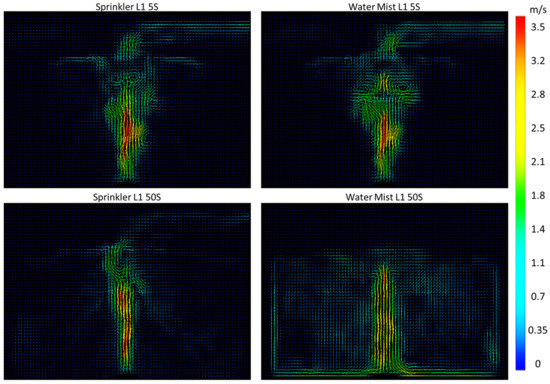
Figure 9.
Velocity vector for sprinkler and water mist systems at location 1, before and during fire suppression.
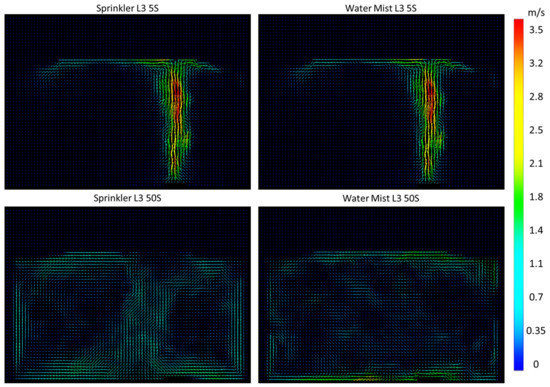
Figure 10.
Velocity vector for sprinkler and water mist systems at location 3, before and during fire suppression.
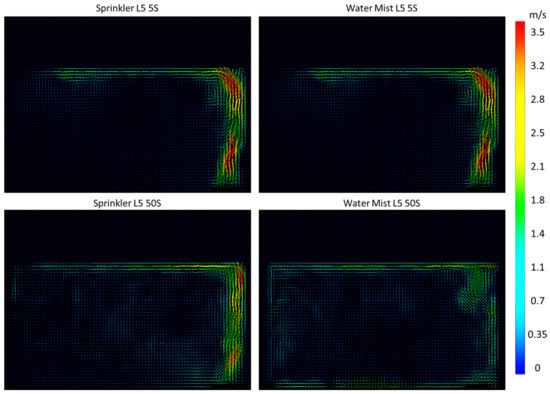
Figure 11.
Velocity vector for sprinkler and water mist systems at location 5, before and during fire suppression.
5. Conclusions
This study performed quantitative numerical simulations to investigate the fire suppression behaviour of both sprinklers and water mist system on compartment fire with different fire source locations. Five fuel locations along the axis between the centre and corner of the room were configurated, namely locations 1–5, where the methanol fuel pan was relocated 0.4 m away from the nozzle in both X- and Y-axis for each location. The advantages and limitations for both systems were revealed via a comparison of HRR and temperature reduction, droplet spray pattern and also the velocity field at different suppression stages and fuel locations. The findings in this study can be summarised in the following key points:
- The fire sprinklers have exhibited significant fuel surface cooling effect that has suppressed the 50 kW HRR profiles effectively in from location 2–4 within 50 s. This can be attributed to the larger droplets (>1000 µm) sprayed from sprinklers carry more momentum and heat capacity, which forms a wide spray pattern that mainly covers locations 2 to 4 and provides better droplet penetrability toward the fire.
- Within the coverage area, the large droplets also evaporate slower than mist and create a downward velocity field against the flame plume. Despite the heat reduction from locations 2–4, the sprinklers are relatively weaker than water mist while the fuel pan was relocated at location 1 and 5, which is vertically below the nozzle and out of droplets coverage area.
- Regardless of fire suppression outcome (i.e., either fire has been fully suppressed or not), it can be seen that the water mist systems are able to rapidly cool down temperature near fuel source to a low value at all scenarios. Except for location 5, all the temperatures over 0.2 m above the fire have been suppressed below 100 °C within 20 s. This has exhibited the advantages of water mist, even though the mist droplets did not effectively reduce the HRR from locations 3–5 due to insufficient droplet transportation on the fuel surface, which can be attributed to small spray coverage or early droplet evaporation.
- Mist droplets often lose momentum after leaving the nozzle due to drag from air and buoyancy induced by fire; thus, the droplets are unable to travel along the intended trajectory with long horizontal distances. The water mist system can still eject micro-sized water droplets with rapid evaporation surrounding the flame and effectively stabilise the local temperature field at the fuel locations.
In this study, the quantitative assessment of fuel locations could also contribute to the future development of performance-based fire safety designs, for example, household open-kitchen compartment settings, confirmed car parking spaces and aircraft/train/submarine/ferry cabins, etc. With a highlighted emphasis on the different fire locations, this numerical approach can deliver additional insights on the effectiveness of water-mist systems for coverage of large distance fires.
Author Contributions
Conceptualization, I.M.D.C.C. and H.L.; methodology, I.M.D.C.C.; software, I.M.D.C.C.; validation, T.B.Y.C., H.L.; formal analysis, C.W., R.C.; investigation, I.M.D.C.C.; resources, G.H.Y.; data curation, A.L.; writing—original draft preparation, I.M.D.C.C., H.L.; writing—review and editing, A.L.; visualisation, H.L.; supervision, A.C.Y.Y.; project administration, G.H.Y.; funding acquisition, G.H.Y. All authors have read and agreed to the published version of the manuscript.
Funding
This research was sponsored by the Australian Research Council (ARC Industrial Transformation Training Centre IC170100032).
Acknowledgments
All financial and technical support are deeply appreciated by the authors.
Conflicts of Interest
The authors declare no conflict of interest.
References
- Yuen, A.C.Y.; Yeoh, G.H.; Alexander, B.; Cook, M. Fire scene investigation of an arson fire incident using computational fluid dynamics based fire simulation. Build. Simul. 2014, 7, 477–487. [Google Scholar] [CrossRef]
- Hub, A.D.R.K. Fire-Urban-Quakers Hill Nursing Home, Sydney. Available online: https://knowledge.aidr.org.au/resources/fire-urban-quakers-hill-nursing-home-sydney-2011/ (accessed on 19 November 2022).
- Yuen, A.C.Y.; Chen, T.B.Y.; Li, A.; De Cachinho Cordeiro, I.M.; Liu, L.; Liu, H.; Lo, A.L.P.; Chan, Q.N.; Yeoh, G.H. Evaluating the fire risk associated with cladding panels: An overview of fire incidents, policies, and future perspective in fire standards. Fire Mater. 2021, 45, 663–689. [Google Scholar] [CrossRef]
- Cao, R.F.; Lee, E.W.M.; Yuen, A.C.Y.; Chen, T.B.Y.; De Cordeiro, I.M.C.; Shi, M.; Wei, X.; Yeoh, G.H. Simulation of competitive and cooperative egress movements on the crowd emergency evacuation. Simul. Model. Pract. Theory 2021, 109, 102309. [Google Scholar] [CrossRef]
- Hall, J.R.; Ahrens, M.; Evarts, B. Sprinkler Impact on Fire Injury; Fire Protection Research Foundation: Quincy, MA, USA, 2012. [Google Scholar]
- Hoffmann, N.A.; Galea, E.R. An extension of the fire-field modelling technique to include fire-sprinkler interaction—I. The mathematical basis. Int. J. Heat Mass Transf. 1993, 36, 1435–1444. [Google Scholar] [CrossRef]
- Zlatanovic, L.; Vreeburg, J.; van der Hoek, J.P.; Poznakovs, I. An experimental study on the spray characteristics of residential sprinklers under low-flow and low-pressure conditions. Fire Saf. J. 2014, 68, 30–40. [Google Scholar] [CrossRef]
- Zhou, Y.; Bu, R.; Gong, J.; Zhang, X.; Fan, C.; Wang, X. Assessment of a clean and efficient fire-extinguishing technique: Continuous and cycling discharge water mist system. J. Clean. Prod. 2018, 182, 682–693. [Google Scholar] [CrossRef]
- Chow, W.K.; Yao, B.; Ng, M.Y. Application of Water Mist Fire Suppression Systems in Small Retail Shops. J. Fire Sci. 2002, 20, 479–503. [Google Scholar] [CrossRef]
- Liu, J. Progress in research and application of water mist fire sup-pression technology. Chin. Sci. Bull. 2003, 48, 718–725. [Google Scholar] [CrossRef]
- Chow, W.K.; Shek, L.C. Physical Properties of a Sprinkler Water Spray. Fire Mater. 1993, 17, 279–292. [Google Scholar] [CrossRef]
- Chen, B.; Lu, S.-X.; Li, C.-H.; Kang, Q.-S.; Lecoustre, V. Initial fuel temperature effects on burning rate of pool fire. J. Hazard. Mater. 2011, 188, 369–374. [Google Scholar] [CrossRef]
- Fan, X.; Wang, C.; Guo, F. Experimental study of flame expansion induced by water droplet impact on the burning cooking oil. Fuel 2020, 270, 117497. [Google Scholar] [CrossRef]
- Kim, S.C.; Ryou, H.S. An experimental and numerical study on fire suppression using a water mist in an enclosure. Build. Environ. 2003, 38, 1309–1316. [Google Scholar] [CrossRef]
- Abdulrahman, S.A.; Chetehouna, K.; Cablé, A.; Skreiberg, Ø.; Kadoche, M. A review on fire suppression by fire sprinklers. J. Fire Sci. 2021, 39, 512–551. [Google Scholar] [CrossRef]
- Yao, C.; Kalelkar, A.S. Effect of drop size on sprinkler performance. Fire Technol. 1970, 6, 254–268. [Google Scholar] [CrossRef]
- Gupta, M.; Pasi, A.; Ray, A.; Kale, S.R. An experimental study of the effects of water mist characteristics on pool fire suppression. Exp. Therm. Fluid Sci. 2013, 44, 768–778. [Google Scholar] [CrossRef]
- Ferng, Y.-M.; Liu, C.-H. Numerically investigating fire suppression mechanisms for the water mist with various droplet sizes through FDS code. Nucl. Eng. Des. 2011, 241, 3142–3148. [Google Scholar] [CrossRef]
- Hua, J.; Kumar, K.; Khoo, B.C.; Xue, H. A numerical study of the interaction of water spray with a fire plume. Fire Saf. J. 2002, 37, 631–657. [Google Scholar] [CrossRef]
- Alpert, R.L. Numerical modeling of the interaction between automatic sprinkler sprays and fire plumes. Fire Saf. J. 1985, 9, 157–163. [Google Scholar] [CrossRef]
- Nam, S. Numerical simulation of the penetration capability of sprinkler sprays. Fire Saf. J. 1999, 32, 307–329. [Google Scholar] [CrossRef]
- Chow, W.K.; Fong, N.K. Numerical simulation on cooling of the fire-induced air flow by sprinkler water sprays. Fire Saf. J. 1991, 17, 263–290. [Google Scholar] [CrossRef]
- Wang, Z.; Wang, W.; Wang, Q. Optimization of water mist droplet size by using CFD modeling for fire suppressions. J. Loss Prev. Process Ind. 2016, 44, 626–632. [Google Scholar] [CrossRef]
- Liu, H.; Wang, C.; De Cachinho Cordeiro, I.M.; Yuen, A.C.Y.; Chen, Q.; Chan, Q.N.; Kook, S.; Yeoh, G.H. Critical assessment on operating water droplet sizes for fire sprinkler and water mist systems. J. Build. Eng. 2020, 28, 100999. [Google Scholar] [CrossRef]
- Mahmud, H.; Thorpe, G.; Moinuddin, K.A. The Behaviour of Water-Mists in Hot Air Induced by a Room Fire: Effect of the Initial Size of Droplets. Fire 2022, 5, 116. [Google Scholar] [CrossRef]
- Mahmud, H.I.; Moinuddin, K.A.; Thorpe, G.R. Experimental and numerical study of high-pressure water-mist nozzle sprays. Fire Saf. J. 2016, 81, 109–117. [Google Scholar] [CrossRef]
- Yu, H.-Z.; Kasiski, R.; Daelhousen, M. Characterization of twin-fluid (water mist and inert gas) fire extinguishing systems by testing and modeling. Fire Technol. 2015, 51, 923–950. [Google Scholar] [CrossRef]
- Sikanen, T.; Vaari, J.; Hostikka, S.; Paajanen, A. Modeling and simulation of high pressure water mist systems. Fire Technol. 2014, 50, 483–504. [Google Scholar] [CrossRef]
- Gui, J.; Wang, D.; Jiang, Y.; Liu, J.; Yang, L. Study on the Protection Effect of Sprinklers on Glass by Fire Scale in Building Fires. Fire 2022, 5, 100. [Google Scholar] [CrossRef]
- Nmira, F.; Consalvi, J.-L.; Kaiss, A.; Fernandez-Pello, A.; Porterie, B. A numerical study of water mist mitigation of tunnel fires. Fire Saf. J. 2009, 44, 198–211. [Google Scholar] [CrossRef]
- Lee, J.; Moon, J. Numerical analysis of the effect of horizontal distance between a water mist nozzle and ignition source on reduction in heat release rate. Ann. Nucl. Energy 2020, 144, 107560. [Google Scholar] [CrossRef]
- Kim, S.C.; Ryou, H.S. The effect of water mist on burning rates of pool fire. J. Fire Sci. 2004, 22, 305–323. [Google Scholar] [CrossRef]
- Frank, K.; Gravestock, N.; Spearpoint, M.; Fleischmann, C. A review of sprinkler system effectiveness studies. Fire Sci. Rev. 2013, 2, 6. [Google Scholar] [CrossRef]
- Beji, T.; Zadeh, S.E.; Maragkos, G.; Merci, B. Influence of the particle injection rate, droplet size distribution and volume flux angular distribution on the results and computational time of water spray CFD simulations. Fire Saf. J. 2017, 91, 586–595. [Google Scholar] [CrossRef]
- Sumon, S.M.; Sang-Wook, L. Efficiency of water mist on fire suppression: A numerical study. In Proceedings of the International Forum on Strategic Technology 2010, Ulsan, Korea, 13–15 October 2010; pp. 10–14. [Google Scholar]
- Bhamare, D.K.; Rathod, M.K.; Banerjee, J. Numerical model for evaluating thermal performance of residential building roof integrated with inclined phase change material (PCM) layer. J. Build. Eng. 2020, 28, 101018. [Google Scholar] [CrossRef]
- De Cachinho Cordeiro, I.M.; Liu, H.; Yuen, A.C.Y.; Chen, T.B.Y.; Li, A.; Cao, R.F.; Yeoh, G.H. Numerical investigation of expandable graphite suppression on metal-based fire. Heat Mass Transf. 2022, 58, 65–81. [Google Scholar] [CrossRef]
- Li, A.; Yuen, A.C.Y.; Wang, W.; Chen, T.B.Y.; Lai, C.S.; Yang, W.; Wu, W.; Chan, Q.N.; Kook, S.; Yeoh, G.H. Integration of Computational Fluid Dynamics and Artificial Neural Network for Optimization Design of Battery Thermal Management System. Batteries 2022, 8, 69. [Google Scholar] [CrossRef]
- Duny, M.; Dhima, D.; Garo, J.P.; Wang, H.Y. Numerical investigation on window ejected facade flames. J. Build. Eng. 2016, 8, 305–312. [Google Scholar] [CrossRef]
- Yuen, A.C.Y.; Chen, T.B.Y.; Yang, W.; Wang, C.; Li, A.; Yeoh, G.H.; Chan, Q.N.; Chan, M.C. Natural ventilated smoke control simulation case study using different settings of smoke vents and curtains in a large Atrium. Fire 2019, 2, 7. [Google Scholar] [CrossRef]
- Chen, T.B.Y.; Yuen, A.C.Y.; Yeoh, G.H.; Yang, W.; Chan, Q.N. Fire risk assessment of combustible exterior cladding using a collective numerical database. Fire 2019, 2, 11. [Google Scholar] [CrossRef]
- Yuen, A.C.Y.; De Cachinho Cordeiro, I.M.; Chen, T.B.Y.; Chen, Q.; Liu, H.; Yeoh, G.H. Multiphase CFD modelling for enclosure fires—A review on past studies and future perspectives. Exp. Comput. Multiph. Flow 2021, 4, 1–25. [Google Scholar] [CrossRef]
- Rehm, R.G.; Baum, H.R. The equations of motion for thermally driven buoyant flows. J. Res. NBS 1978, 83, 297–308. [Google Scholar] [CrossRef]
- Nicoud, F.; Ducros, F. Subgrid-Scale Stress Modelling Based on the Square of the Velocity Gradient Tensor. Flow Turbul. Combust. 1999, 62, 183–200. [Google Scholar] [CrossRef]
- Chen, T.B.Y.; De Cachinho Cordeiro, I.M.; Yuen, A.C.Y.; Yang, W.; Chan, Q.N.; Zhang, J.; Cheung, S.C.P.; Yeoh, G.H. An Investigation towards Coupling Molecular Dynamics with Computational Fluid Dynamics for Modelling Polymer Pyrolysis. Molecules 2022, 27, 292. [Google Scholar] [CrossRef]
- Yuen, A.C.Y.; Chen, T.B.Y.; De Cachinho Cordeiro, I.M.; Liu, H.; Li, A.; Yang, W.; Cheung, S.C.P.; Chan, Q.N.; Kook, S.; Yeoh, G.H. Developing a solid decomposition kinetics extraction framework for detailed chemistry pyrolysis and combustion modelling of building polymer composites. J. Anal. Appl. Pyrolysis 2022, 163, 105500. [Google Scholar] [CrossRef]
- De Cachinho Cordeiro, I.M.; Chen, T.B.Y.; Yuen, A.C.Y.; Wang, C.; Chan, Q.N.; Zhang, J.; Yeoh, G.H. Pyrolysis and combustion characterisation of HDPE/APP composites via molecular dynamics and CFD simulations. J. Anal. Appl. Pyrolysis 2022, 163, 105499. [Google Scholar] [CrossRef]
- Li, A.; Yuen, A.C.Y.; Wang, W.; Weng, J.; Yeoh, G.H. Numerical investigation on the thermal management of lithium-ion battery system and cooling effect optimization. Appl. Therm. Eng. 2022, 215, 118966. [Google Scholar] [CrossRef]
- Cheremisinoff, N.P. Encyclopedia of Fluid Mechanics. Volume 3: Gas-Liquid Flows; Gulf Publishing: Houston, TX, USA, 1986. [Google Scholar]
- Yu, H.-z.; Lee, J.L.; Kung, H.-C.; Brown, W. Suppression of rack-storage fires by water. Fire Saf. Sci. 1994, 4, 901–912. [Google Scholar] [CrossRef]
- Hamins, A.; McGrattan, K.B. Reduced-Scale Experiments to Characterize the Suppression of Rack-Storage Commodity Fires; NIST Interagency/Internal Report (NISTIR), National Institute of Standards and Technology: Gaithersburg, MD, USA, 1999.
- Lee, J. Numerical analysis on the rapid fire suppression using a water mist nozzle in a fire compartment with a door opening. Nucl. Eng. Technol. 2019, 51, 410–423. [Google Scholar] [CrossRef]
- Beyler, C. Chapter 7: Flammability Limits of Premixed and Diffusion Flames. In Section Two, SFPE Handbook of Fire Protection Engineering, 3rd ed.; National Fire Protection Association: Quincy, MA, USA, 2002. [Google Scholar]
- Liu, H.; Cachinho Cordeiro, I.M.D.; Yin Yuen, A.C.; Chan, Q.N.; Kook, S.; Yeoh, G.H. Application of multi-parametric characterization to water-based fire suppression systems in compartment fire scenarios. Numer. Heat Transf. Part A Appl. 2022, 1–19. [Google Scholar] [CrossRef]
- Liu, H.; Yuen, A.C.Y.; De Cachinho Cordeiro, I.M.; Han, Y.; Yuan Chen, T.B.; Chan, Q.N.; Kook, S.; Yeoh, G.H. A novel stochastic approach to study water droplet/flame interaction of water mist systems. Numer. Heat Transf. Part A Appl. 2021, 79, 1–27. [Google Scholar] [CrossRef]
- Bourque, M.J.; Svirsky, T.A. Computational Modeling of Fire Sprinkler Spray Characteristics Using the Fire Dynamics Simulator. Bachelor’s Thesis, Worcester Polytechnic Institute, Worcester, MA, USA, 2013. [Google Scholar]
- Lehtimäki, M. Simulation of Water Cooling in Fires. Master’s Thesis, Aalto University, Espoo, Finland, 2017. [Google Scholar]
- DiNenno, P.J. SFPE Handbook of Fire Protection Engineering; Springer: Berlin/Heidelberg, Germany, 2008. [Google Scholar]
Publisher’s Note: MDPI stays neutral with regard to jurisdictional claims in published maps and institutional affiliations. |
© 2022 by the authors. Licensee MDPI, Basel, Switzerland. This article is an open access article distributed under the terms and conditions of the Creative Commons Attribution (CC BY) license (https://creativecommons.org/licenses/by/4.0/).